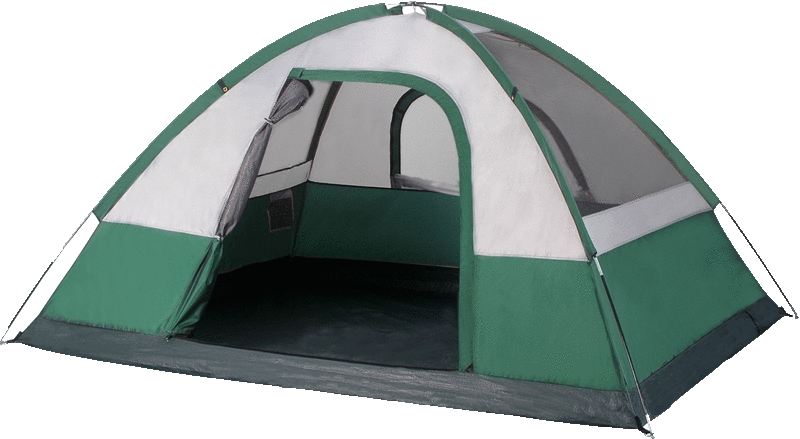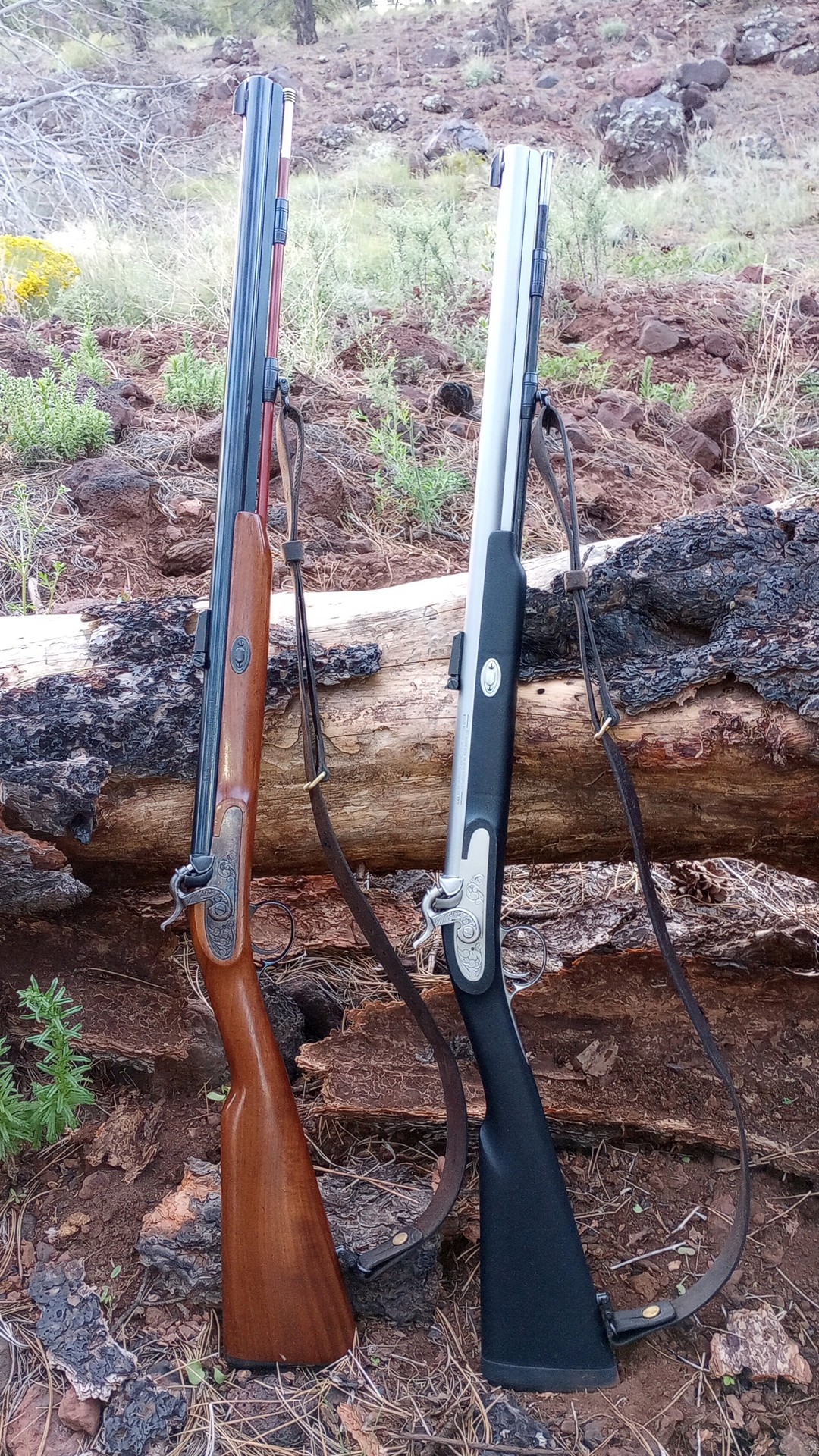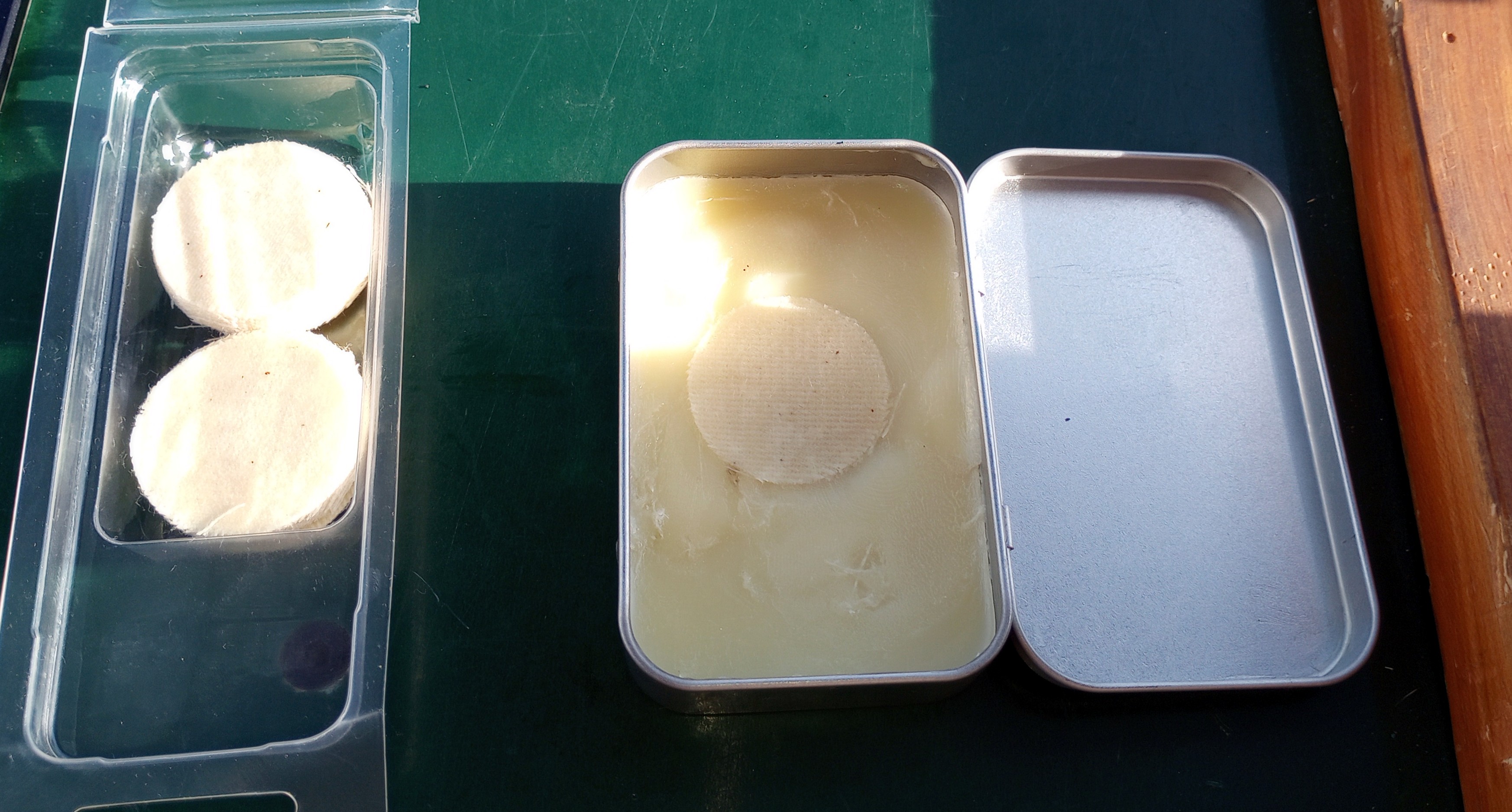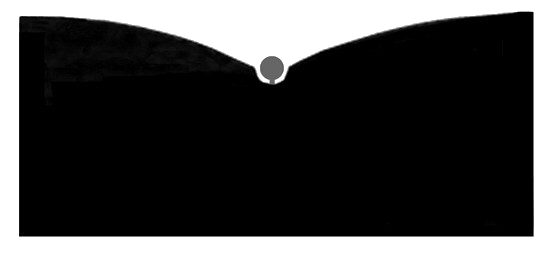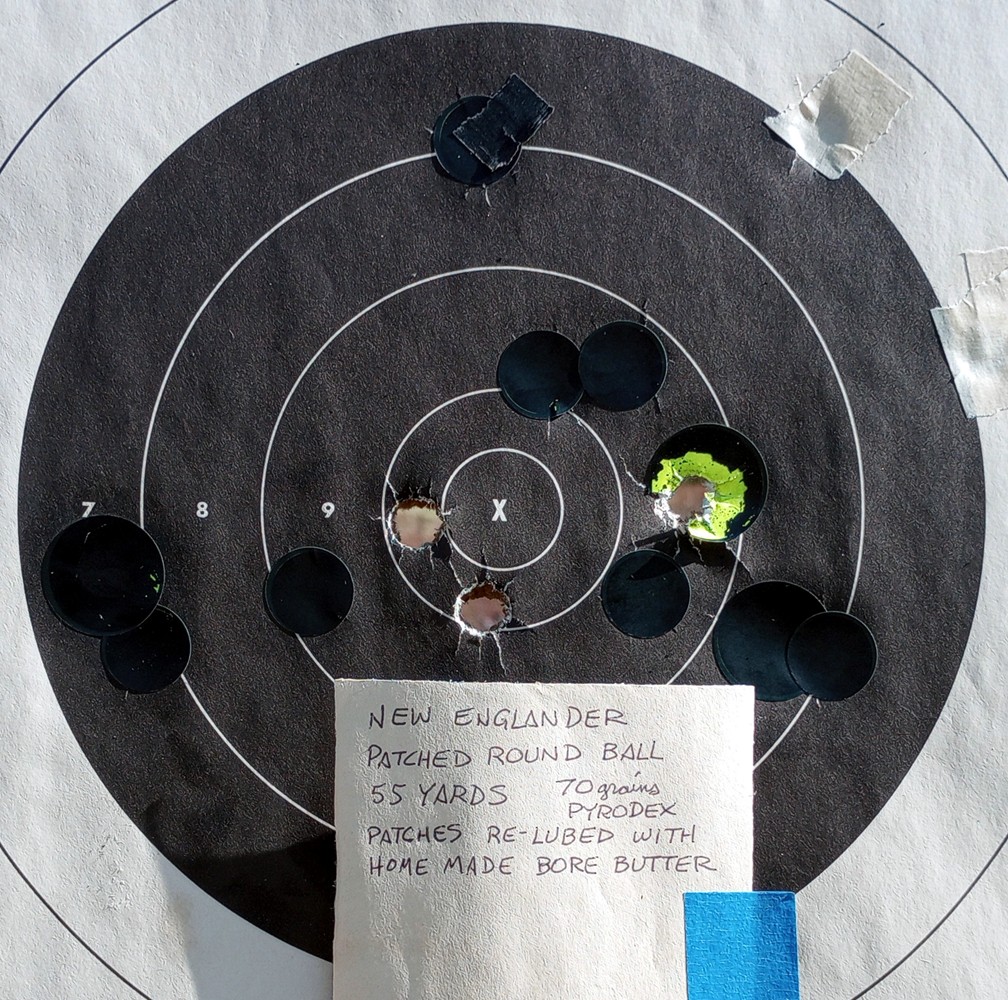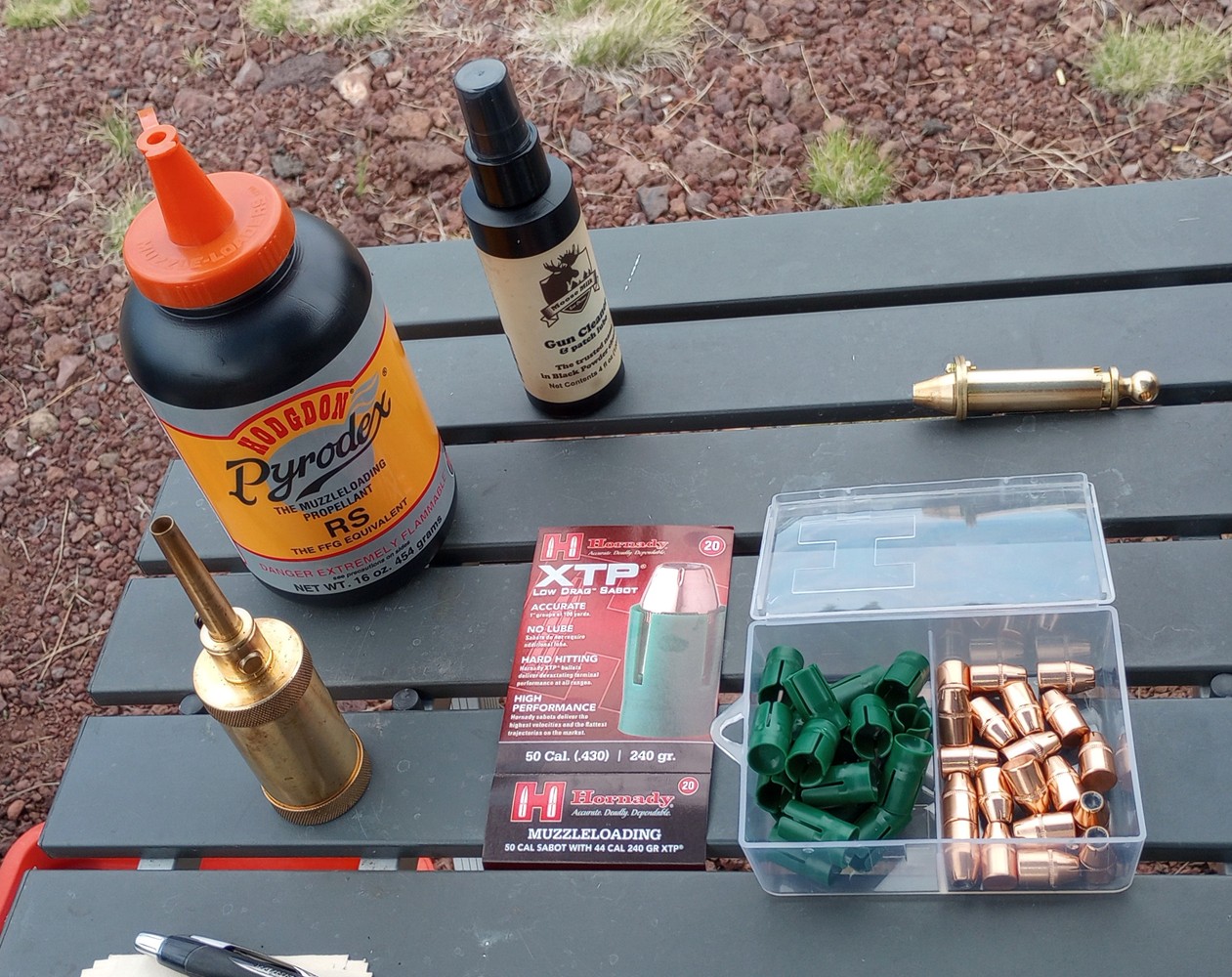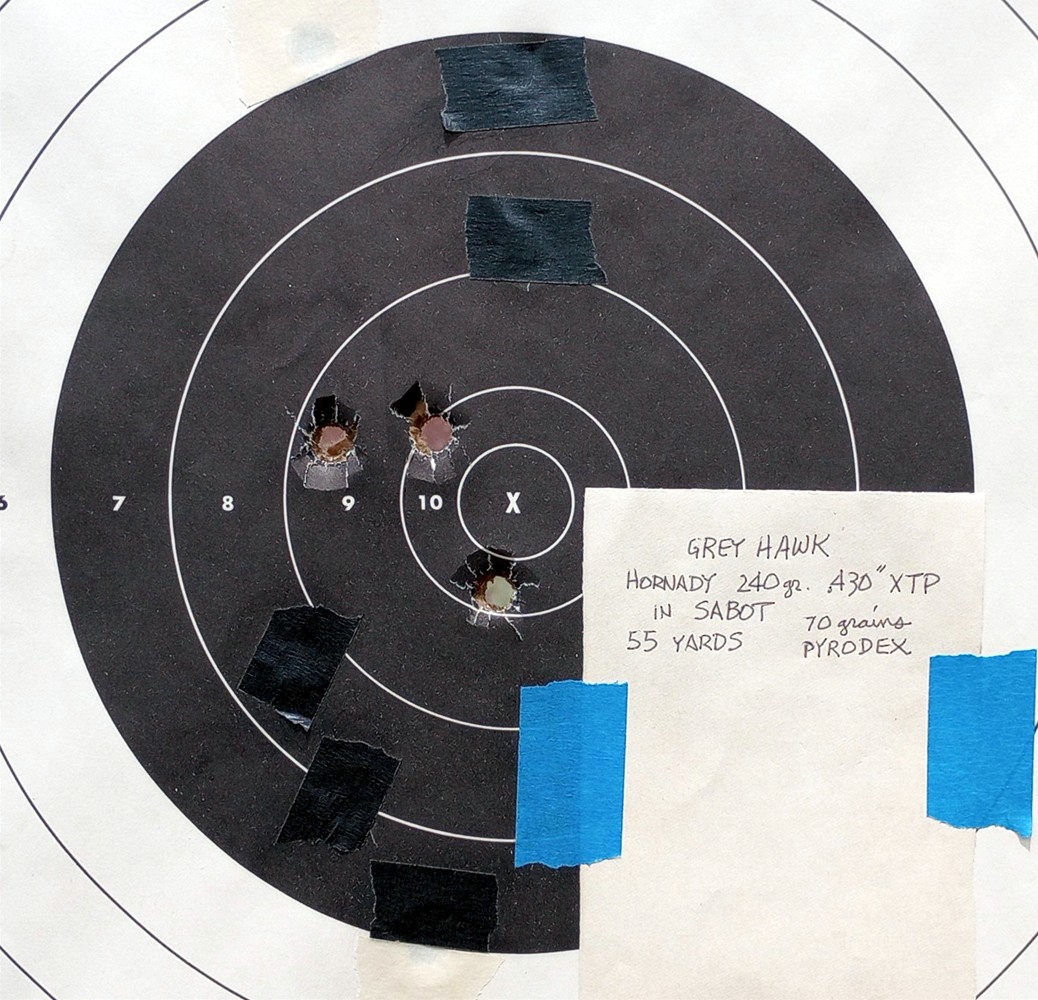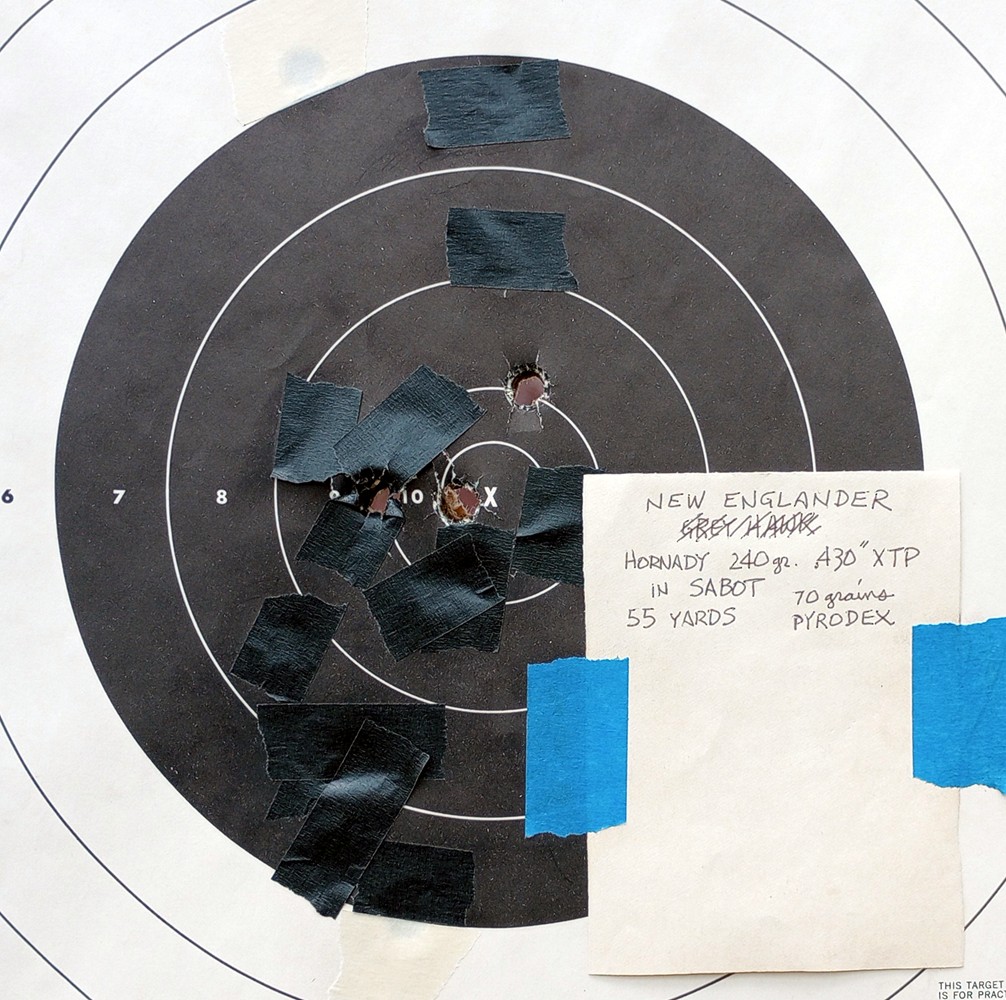Since writing “Smokepole” (part I) last
month, I got a second opportunity to spend a full day of muzzleloader shooting.
But you might notice in the photo to the right, that there are now two black powder
rifles pictured. On the left is the Thompson/Center New Englander from last month’s
story, and to the right of that is a Grey Hawk that I discussed was my first black
powder rifle that I used to own in the mid-’90’s.
After buying the New Englander on Gunbroker.com, I kept an eye out on Gunbroker, just
continuing to monitor the T/C black powder rifles for sale. I spotted this Grey Hawk,
which appeared to be in excellent condition, in .50 caliber, therefore of compatible
caliber to the New Englander, and I just could not resist hitting the button to buy it.
When the Grey Hawk arrived, I was very pleased to find that it had a pristine bore.
If you recall from last time, I was pretty disappointed to find a dirty and ugly bore
in the New Englander. My initial accuracy results from shooting the New Englander were
disappointing as well. I had hoped that I would be able to wring acceptable accuracy
out of it anyway, but my first shooting session was discouraging. I did not reach the
conclusion that it was due to the ugly bore, but my suspicion strongly leaned that way.
From here on out, I will refer to the two rifles as “NE” (New Englander), and “GH”
(Grey Hawk), to save myself some typing. Now having the GH with a good bore, a
back-to-back benchrest comparison with the NE should reveal whether or not the ugly
NE bore was the source of my bad accuracy, or if the problem was something else –
something in my loading, cleaning, or sighting techniques for example.
I went back up to my high country Schützen kamp to spend a couple of nights in
somewhat cooler Arizona summer temperatures. There, without distraction, I can take
the time needed to shoot groups with both of these slow-to-reload rifles, to be able
to draw valid conclusions.
The last time, I was kind of all over the place with powder charges, shooting distance,
and sight hold. I decided that I needed to standardize things for this testing. I
decided on the following standards:
- 70 grain powder charge
- Patched round balls (1st projectile)
- Saboted Hornady .44 cal. XTP (2nd projectile)
- Three, three-shot groups for each projectile, from each rifle
- Distance: 50 meters (55 yards)
- No bore swabbing between shots
- Sight picture: front sight ball nestled into the valley of the rear sight, front
sight covering bullseye
I still had the half-hearted goal of going javelina hunting with one of these traditional
muzzleloaders. Not deer hunting, not elk hunting - both of those are more challenge than
I care to take on with a traditional iron-sighted black powder rifle. A 70 grain charge
is a mid-range load, but quite enough to put the smack-down on a peccary.
Based on my first attempt at grouping with the NE, I had tempered my distance expectations.
Before shooting the black powder rifles, I had to check the zero on my .22 target pistol –
the one I use for .22 pistol silhouette shooting. I like to zero at the pig distance which
is 50 meters. After sighting-in the pistol, I figured that the 50 meter distance was a good
one for testing the muzzleloaders as well.
For shooting the patched round balls, since I had cooked up some home-made bore butter, I
also decided to re-lube, the pre-lubed patches with my bore butter.
It seemed to me that the pre-lubed patches I had were actually rather dry. I would place
a patch into the tin with my bore butter and rub my finger over the patch until I could see
that the bore butter had fully saturated it. I think that this also had the advantage of
swabbing the bore each time I loaded a new ball, as it would push any fouling back down into
the powder chamber to be re-burned at ignition. Sure, the un-relubed patches would also do
this to some degree, but I think the double-lubed patches did better because they were more
moist.
Though I did not wet-patch, dry-patch swab after every shot this time, as I did last time,
I did clean the bore before switching over to the saboted rounds after shooting patched
round balls.
I also paid better attention to centering the patch over the muzzle before starting a ball
down the bore this time. I paid only haphazard attention to this factor last time. When I
made up the bore butter, I also made some pre-saturated patch strips for cutting off at the
muzzle with a patch knife, but I did not get around to testing this technique on this trip.
As to the sight picture, let me refresh the readers on what it looks like. Last time out I
had trouble deciding whether to hold the ball of the front sight down in the valley of the
rear sight, or whether to hold it a little high to show some of the post of the front sight.
For this testing and sighting-in, I decided that no post should be visible. The ball of the
front sight is almost the same diameter as the 8” black bullseye of the target I was using
at the 50 meter distance. My sight picture would be ball-on-ball, front sight ball at the
bottom of the rear sight valley.
First up was the NE shooting patched round balls. I started by taking several shots to
adjust the sights to hit as centered as possible using the sight picture that I had decided
on, using the charge weight that I had chosen. Then I settled down to group shooting.
I mentioned last time, that I felt that if I could keep all the hits in the black, then I
might consider me and the gun ready to hunt. For my first group, one of the three shots
landed in the white. I made another sight adjustment to bring the group left.
The next group was still a little to the right, but these were all in the black, and the
group was also tighter. I made another leftward sight adjustment.
The final group was well-centered, and the tightest yet. Hey, it looks like I’m making
progress here! I’m thinking that re-lubing the patches with my bore butter is making the
difference in improving shot consistency as contrasted with all the inconsistency I saw in
my first session.
On to the GH shooting patched round balls. For my first sighting shots with the GH, I ran
into a snag with my chosen sight picture. With the rear sight cranked all the way down, I
was still hitting a little high with the ball-on-ball, front-sight-in-the-rear-sight-valley
hold. I was able to adjust windage to center the group, but I had to change my hold to bring
the shots down to center elevation. I found that I had to let about 1/3 of the bullseye-ball
peek above the ball of the front sight. Consistently keeping this imprecise hold from
shot-to-shot was not as easy as the ball-on-ball hold.
I ended up shooting a fourth group with the GH because the third group came out to nearly
5 inches. Was it me? The fourth group was better, but confirmed for me that the NE overall
shot better than the GH.
It was time to move on to the sabots. I mentioned last time that back in the day with my
original Grey Hawk, I had never tried saboted pistol bullets, so this would be new territory
for me.
These saboted pistol bullets are by Hornady. The package contains 20 green sabots and 20
.430” 240 gr. Hornady XTP pistol bullets. This was just enough for today’s experimentation.
This would allow three 3-shot groups in each rifle, plus two extras for a little fun blasting.
I decided to start with the GH this time. I cleaned the barrel using moose milk and cleaning
patches until the patches came out clean. I wiped down the area of the barrel around the
nipple where nipple blow-back happens. The gun was as clean as you can get without
disassembling it and soaking the breech in a bucket of hot water.
It's simple to slip the bullet into the sabot and start the assembly down the barrel. The
bottom of the sabot is slightly undersized, so it starts into the muzzle easily. Then you
push it fully down into the bore using the short starter to engage the rifling, then the ram
rod. The sabots offer less resistance going down the bore than the patched round balls do.
I decided not to make any further sight adjustments while shooting the sabots. I wanted to
leave the sights adjusted for the round balls. Once more, I would need to adjust my hold to
center the groups in the bullseye.
Results were encouraging. I was definitely seeing tighter grouping using the sabots than I
saw with the patched round balls. In fact, take a look at the last sabot group I fired in
the GH. It measures just under 2 inches.
But once again, the NE with its uglier bore proved to shoot even tighter groups using the
sabots. The best group put two bullets into the same hole and measured 1.08”. Here is the
last group, the second best group at 1.70”:
Sorry for all the tape obscuring the holes in that last picture, but chewing out the center
of the target is a good thing, right? All three shots were ten-pointers.
Here is the group size summary for saboted XTPs:
Setting aside the cost of the powder charge and percussion cap, shooting round balls costs
about 30¢ per shot. The Hornady saboted bullets cost about 98¢ per shot. Buying a box of
100 XTPs plus some Harvester brand sabots can bring the cost down to about 75¢ per sabot shot.
I decided to leave the sights adjusted for round balls for now, mainly because I see these
guns as fun plinkers, more than serious hunting machines. There is just something satisfying
and relaxing about all the manipulation it takes to get off a single shot. Plinking with
round balls is a lot of fun, but have no doubt about how much damage a .50 caliber pure lead
ball can do. See the image sequence at the bottom.
This testing has answered a couple of outstanding questions. Was the bore of the NE ruined?
No. It actually shot more accurately than the GH with a pristine bore.
Could I make these muzzleloaders shoot accurately enough to hunt javelina? Yes! If I decide
to hunt javelina, it will be with the New Englander shooting saboted .44 caliber XTPs. But I
will keep a 6-shooter on my hip and not leave it behind next time!
The other thing I learned is how sensitive point-of-impact is to how you hold the sights. To
shoot my best groups I really had to concentrate on the sight picture, and do my darndest to
replicate the exact same sight picture for every shot in the group. When you are used to
shooting groups with modern scoped rifles, shooting rifle groups with open iron sights is a
humbling revelation!
Before hunting with the NE, I will adjust the sights to center the sabot groups. I will also
try again to measure velocity, something that I did not do during this outing. I will also
test stretching the distance to determine my maximum ethical range. Based on these results,
I should be able to achieve at least 75 yards, but 100 yards could be iffy on the little
peccary. There is plenty of opportunity for continued experimentation in the future.

Effect of a .50 cal. patched round ball on a 12 oz. plastic soda bottle. |

![]()
